
The Shaanxi Province of China is very rich in cultural relics. Shaanxi History Museum is an elegant and dignified structure on a large scale with combination of traditional architecture and modern technology. It was built on a total land area of 65,000 sq. meter in ancient city of Xian in year 1983 and opened to public in mid 1991. Shaanxi's history, culture and Chinese ancient civilization are displayed in this artistic hall building. The building complex is architecturally in the style of Tang Dynasty with a main hall in center and storied buildings in corners, accessible by elevators. The Museum used to be known as an ancient capital pearl and a Chinese treasure house, is one of the first huge state museums with modern facilities in China.


The museum houses over 370,000 precious relics unearthed in the Province of Shaanxi in Tang's tombs, including murals, paintings, coins, bronze, silver and gold wares, pottery figures.


Buddhist missionaries had begun the difficult journey from North India to China as early as 1st century but it was not so successful until Tang Dynasty (618-907). Buddhism reached its maturity and was at its peak period during early Tang era. The Tang's emperors made Buddhism a big part of China, especially Empress Wuzetian and Emperor Taizong, who financially supported the monasteries, gave power to monks and sent representatives to India, to collect Buddhist Texts. They gave orders to construct Buddhist temples, to create Buddhist sculptures and paintings, to build Buddhist statues across China. Tang era was the most prosperous period of Buddhism as well as a great age of pilgrimages to India, the cradle of Buddhism.


Land and sea route of the two great monks who traveled to India to seek Buddha's teachings. Master Xuanzang of Tang Dynasty traveled to India for 17 years (629-645) and brought back with him 500 crates of books and materials. After coming back, he spent all his years in Xian translating Buddhist documents into Chinese and promoting his faith in Buddhism. Before Xuanzang, Master Faxian (337-424) undertook a trip via central Asia to India in year 399 and returned to China by sea in year 414. He visited the birthplace of Buddha, Lumbini of Nepal, and stayed in Sri Langka for 2 years. He was caught in storm and landed in several unknown places like Indonesia for months before safely arrived the east coast of China. He spent the rest of his life in Shandong to translate and edit the scriptures collected back from India.


The Chinese Zodiac - the twelve animals figuring, a colorful devas sculpture and an image of Bodhisattva Guan Yin (Goddess of Mercy) are among the displays.



Oil lamp holder and cooking utensils are some relics unearthed.



Beautifully designed pot and container and ancient pointed-based water flask.



Wine vessel and container.




Wine Vessels and container.



Tally was kind of special token used by Emperor to transmit his order and to confer military power. It comprises of two halves, in which one to be kept by imperial and one to be hold by the commander. Military Order was only considered valid when left and right tally merged into one complete piece.


Unearthed clay horse and a precised gold gilded deer.


The map of China showing the present places of three kingdoms and a summary list of dynasties and their emperors after three kingdoms. Another tablet indicating the reigning period of the eleven emperors of Western Han Dynasty and the possible spot of their tombs. The diplomat route to foreign countries via land and sea during Han Dynasty are also clearly shown on a map.




Ancient seals.


The seal of Dugu Xui, a famous minister of Western Wei Dynasty. It is spherical in shape with 8 ridges including 18 square facets and 8 triangular facets. The 14 square faces bear engraved characters indicating different functions and titles.


Gorgeous gold gilded bowl and the water pot with loop in phoenix design and spout in lion design. The lid and body of the pot are connected together and when pouring in water, it has to be placed up-side down, allowing the flow from a plum-shaped hole at the base. The pouring in tube was able to hold the water preventing the leakage from the bottom when the pot was placed upright.

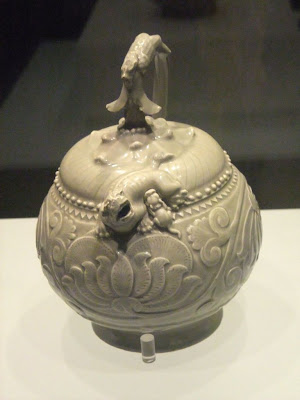

Celadon bottom filled-in kettle from Five Dynasty (907-960).

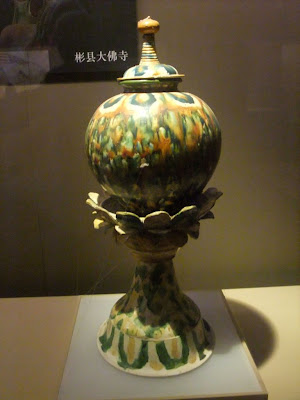

An ancient mirror from Sui Dynasty (581-618)


Hair style of women in Tang Dynasty.
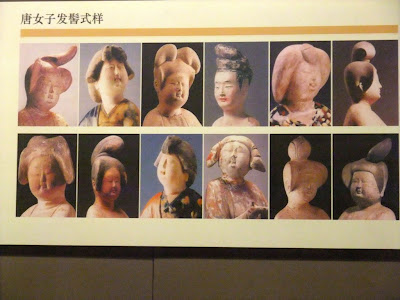

Painted woman figures - Tang Dynasty (618-907).




Tri-color (Sancai) Camel and Ceramic Horse.



The fine glass products.
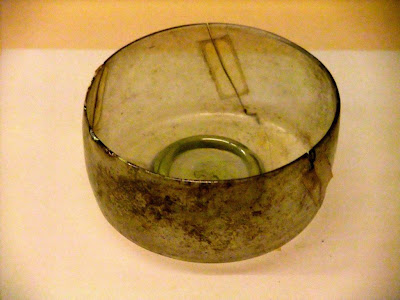

Qin Shi Huang of Qin Dynasty (221-206BC) was the king who united China. He conquered the other five states and unified the wordings as well as money used.



Qin Dynasty had great influences over China's history although it only lasted for 15 years for only two emperors, Qin Si Huang and his son.




The wall of terracotta worriers' faces in individual facial features.


The terracotta worriers were life-sized, varied in height, uniform and hairstyle in accordance to their rank. Terracotta officers and the kneeling archer, the 120cm tall figure unearth in 1977 from Emperor Qin Shi Huang's tomb.




The largest excavation pit of Terracotta Army from Emperor Qin Shi Huang's tomb. There are over 6000 terracotta worriers and horses in Pit 1, in which 1000 have been unearthed. They are marshaled into a well organized battle array.



The Terracotta worriers were unearthed in Xian at year 1974.


Figure of terracotta warriors and horses plus the unearthed bronze horses and carriage..


We visited Beijing Capital Museum after we left Xian the next day after the visit to Shaanxi History Museum. The Beijing Capital Museum was established in year 1981 with a collection of 83,000 objects, on an original site of a Confucian Temple. The new building covers a total land area of 24,800 sq meter, with 7 layers of floors, five above ground and two underground. It was constructed in Dec 2001 and opened to public in May 2006.


The three main tasks of Beijing Capital Museum are collection and exhibition of cultural relics and undertake related research. Today, it contains more than 200,000 cultural relics in its collection. Main items display in the Museum are cultural relics unearthed in Beijing.


The seated images of Buddha Sakyamuni and Prabhutaratna (1368-1644). Two Buddhas sharing the same seat was derived from Dharma Flower Sutra and they were very popular during North-South Dynasty (420-581)


Images of Bodhisattva.




The gold plated bronze Ksitigarbha Boddhisattva with his two disciples, who were father and son that made offerings to Boddhisattva when he was in the transformation of a Korean Prince in Jiuhuashan Mountains (1368-1644).


The beautifully golden thread knitted monks robes and hand-written Heart-Sutra.



Artifacts from Qing Dynasty: The precious picture of Empress Dowager Ci-Xi taken by a famous western photographer, an incense burner, Royal hat for the king and a retirement's pendant order.




Royal dress accessories embedded with precious stone and the interested ancient pillows.



These are also pillows.


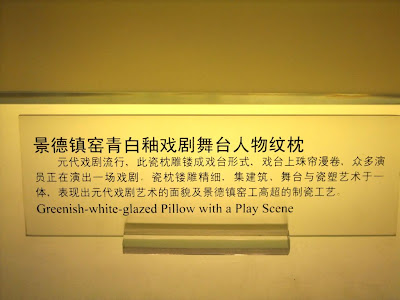
Under-glazed clay wine vessel and Jingdezhen coral red enamel vase (1723-1735)




Porcelain water flask, wine vessel and tea-cup.



The gorgeous glazed porcelain bowl from Yuan Dynasty and the red dish with impressive dragon design.




The opera stage house, wedding traditions, kids ancient games are also part of the exhibitions in Beijing Capital Museum as its exhibitions include on history, building constructions and folk customs of Beijing.




No comments:
Post a Comment